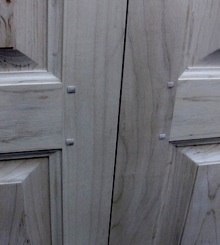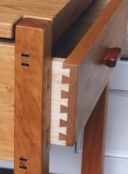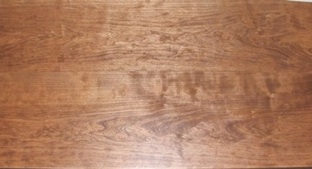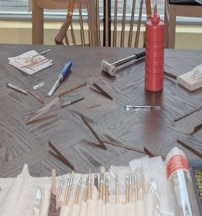Nitty Gritty Furniture Design and Restoration
Custom Furniture - Fitted Cabinets Carousels Refinishing Details Contact Us
Furniture Facts What’s New About Us Our Showroom Useful Links Restoration FAQ’s
Design Cabinetry Woods-Veneers Other Elements Finishing Furniture Styles Furniture Scale
Joinery Doors-Panels Hardware Drawers Crowns Backs Split Cabinets Cabinet Bases - Table Legs
Joinery
Joinery is both a science and an art. It requires master cabinetmakers who have both the knowledge and experience to tackle the most complex custom furniture we build. Our cabinet makers are the best in the province. Their work through-out this site attests to it. Most of our cabinetry today involves classic joinery techniques combined with high strength water-based glues.

The Raw Material
We use over 25 different species of woods in our cabinetry, including from Ontario both reclaimed and newly harvested Ash, Basswood, Beech, Birch, Cedar, Butternut, Cherry, Oak (Red and White), Maple (Hard, Soft, Bird's Eye and Tiger), Pine, Poplar, and Black Walnut. You can see these and other imported woods on our Woods and Veneers page.
We generally order in the wood 1-3 weeks before working with it. That gives us the opportunity to skim plane the wood and sticker it (stack it) in the shop. This allows us to see the grain and watch for signs of movement in the wood. The humidity or moisture in the wood is different at differing depths. By planing the wood initially we can see what happens as the wood re-adjusts to the dry surroundings of our cabinetry shop.
Working with solid wood requires much greater care in handpicking each board to fulfill the various functions in a given piece of furniture. We prefer quarter-cut boards for frames and other structural elements. Quarter cut and flat sawn pieces can be used for panels, and anything else is used for drawer bottoms and backs, minimizing wastage.
You may not know that cabinetry wood does not arrive at the shop as pristine pieces perfect for all use. Nor does it arrive in all the perfect lengths we require. While you can buy 2x4's in given lengths, the cabinetry woods we buy are all sold random length. Furthermore, even though we are purchasing high grade lumber, the wood industry knows that very little wood is defect free, so they grade it with defects. Even in the highest grades, the defect portion allowed can be anywhere from 10-30% depending on species.
As such we need to order an extra 20-30% to work around the defects and build a spectacular piece of furniture. By picking and choosing the pieces, and using the finest pieces for the fronts, sides and tops, we can use the remaining pieces for all other parts of the furniture, reducing waste to a minimum.
Planing, Jointing, Milling and Sanding
Having picked the boards with the correct grain and moisture/movement, we plane to thickness for the project, and joint the boards ready to be glued, milled or shaped into the components for building. Panels, tops and solid gables are the first items to be glued up as they need to be clamped for at least 24 hours prior to further work on them. Once dry and removed from clamps, the panels are then stroke sanded to thickness, cut to size and milled or shaped into the final size. Then they are further sanded to the finishing tolerance required. Usually we sand softwoods to 220 grit, and hardwoods to 150 grit.
Milling the woods including raising panels, profiling edges, turning legs, and creating both mortises and tenons in the framing parts. Sharpening the shaper and router bits is one key to success here. The other is setting the equipment perfectly. We use scrap wood to test each setting to ensure the cut or profile is just perfect.
Glues and Screws
Few people realize that a proper glue joint is stronger than the woods themselves. We use 5000 lb. test water-based glues, in all our cabinetry. They are slow drying, but cure with the greatest strength. Often we will combine finishing nails to help align parts and set both face frames and other elements, immediately prior to clamping We generally use screws to attach cabinet and table tops, backs and other moving elements. The screws, plus the slotted hole used, allow for the solid woods to expand and contract as they do seasonally. It also helps us immeasurable in finishing, where we completely disassemble each completed piece of furniture or cabinetry for finishing inside and out.
Joining
The typical case and table work we do are both based on mortise and tenon joinery as a typical first option, though we do use other differing methods depending on the style, structure and rigidity required. For example, when we built 30 dining tables for a Tim Horton's camp, they asked that all the legs be removable for easy moving and storage
All of the cabinetry we build has drawers dovetailed both front and back. In all solid wood construction (representing most of our work), we use solid wood for the chamfered drawer bottoms, and shiplapped backboards. For post or French style construction we use mortise and tenon and pegged construction. Sometimes the pegs are left unglued, so the cabinet can be disassembled for later moves.
Gluing and other Clamping is more of an art. The prefect pressure keeps enough glue in the joint and holds it to completely dry, usually 24 hours.
Tolerances in all cabinetry have to be just right. The joint can't be too loose to be weak nor too tight so the panels can't move. Depending on the region the furniture is being built for, planning for differing humidity is fundamental.
As an example, when we build for Bermuda, we have to allow extra space for panels to widen, and both drawers and doors to swell.
For more info email us.

© Nitty Gritty Furniture Design
2222216 Ontario Inc.
To join our mailing list, click here.

mail@nittygritty.ca • 416-364-1393 • mail@nittygritty.ca







